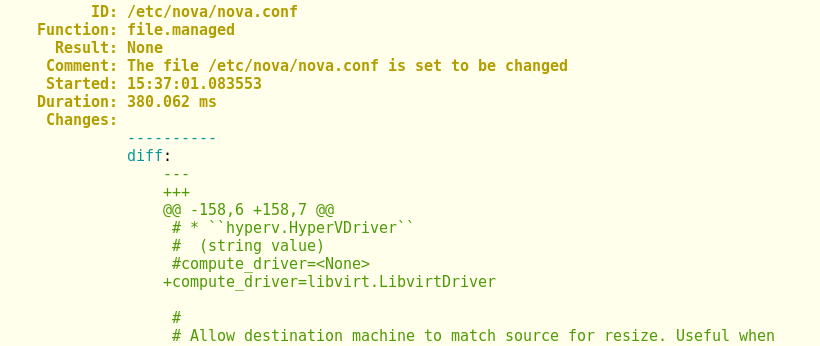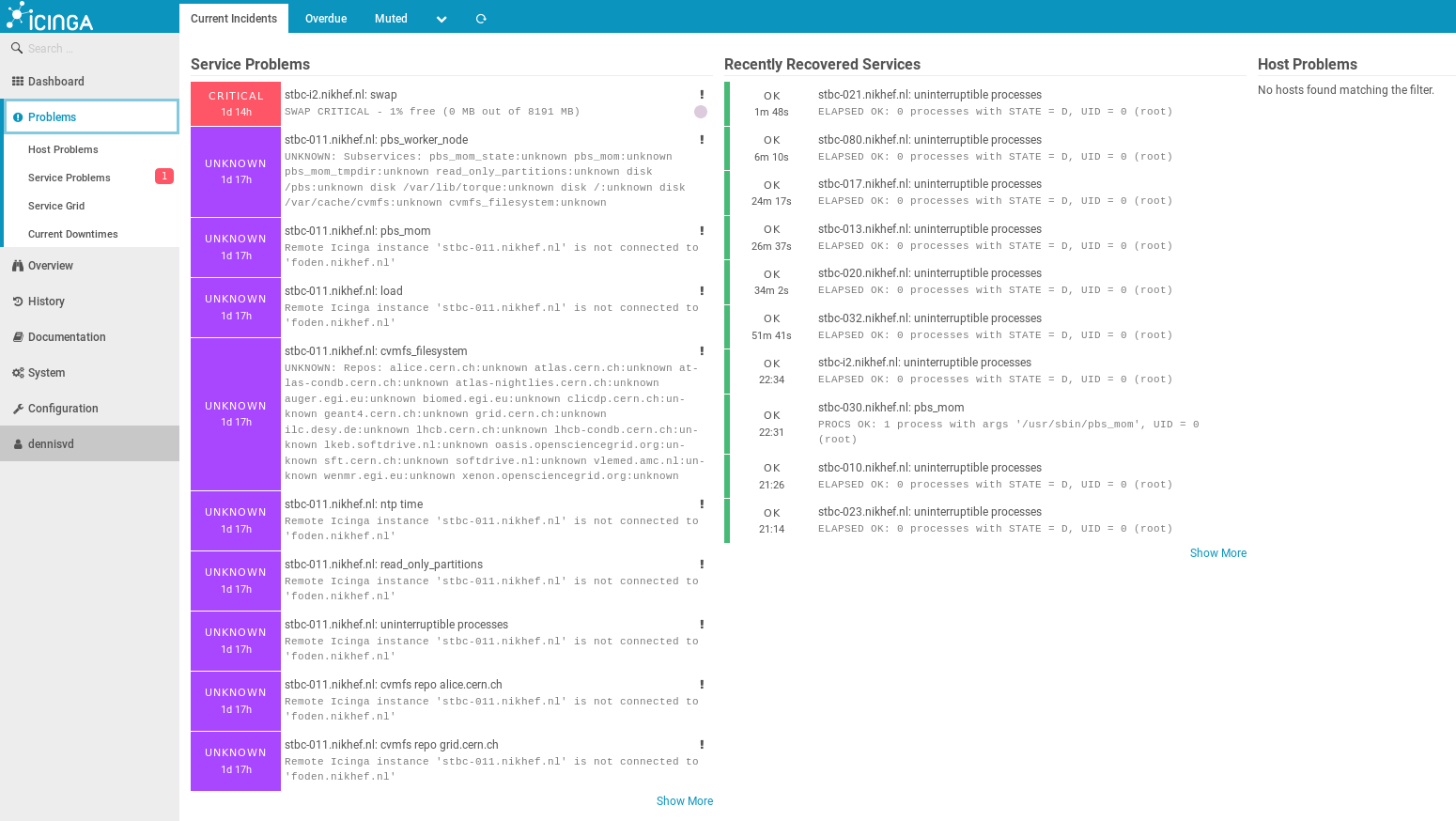First impressions of Saltstack and Reclass
Dennis van Dok
HEPiX Spring 2018 Workshop — Madison, WI, Thursday 2018-05-17
A new Configuration Management system?
We've been using Quattor since the early DataGrid days.
Changing landscape; grid services see less innovation, new CM systems emerged along with growing cloud deployments.
If there ever was a moment to do it, this was it!
About this talk
- not a technical talk
- the journey is more interesting than the destination
- we're got plenty of the road ahead of us
A new system!
Credits to Andrew Pickford!
Looked at quattor upgrade:
- a lot of work
- smallness of quattor community
- they certainly wanted to help
- not easy to get going based on available documentation

Considering several alternatives
(But some were rejected outright based on personal prejudice.)
Two candidates came very close: Saltstack and Ansible with no obvious winner.
Saltstack came out ahead by a nose on technicalities.
(Ansible would have served us just fine.)
What we liked
(Based on previous experiences)
- we really liked the state concept of Saltstack (similar to Quattor).
- Everything is YAML and Python. (And, ok, Jinja2.)
- Nice integration with Reclass (more later).
Test mode shows what would change.
A first look at Saltstack
Discussed (a bit) at HEPiX before.
2016, Sandy Philpott, Site report,
2017, Owen Synge, Technical talk,
Widely used in various open source communities.
This is not a technical talk
(But anyway…)
- master/minion system
- minions controlled by defined states
- static data provided by pillars
- states are logically bundled by formulas
- states are implicitly ordered by dependencies
What goes where
| data source | kind of data | typical examples |
|---|---|---|
| pillar | static per-node | server name, ip address |
| formula | states related to a single aspect | mysql, iptables |
| state | elementary settings | installed packages, running services |
Example of state run in test mode

Organising our data with Reclass
We separated the
- moving parts (states) that are the same for all our nodes from the
- static data specific to each node (pillar).
The pillar is provided by Reclass.
Reclass
A recursive classifier, collecting static hierarchical information about nodes providing pillar data.
Originally http://reclass.pantsfullofunix.net/, but the most active fork at the moment is https://github.com/salt-formulas/reclass/. Our version currently is https://github.com/AndrewPickford/reclass/.
Reclass in a nutshell
(Remember, not a technical talk!)
- Each node specifies which classes it belongs to;
- each class is a file in a hierarchy (i.e. directory structure);
- each class file lists more classes and/or parameters;
- later classes override (simple values) or merge (lists) values from earlier classes.
Reclass example
Example, slightly simplified. This is a dCache master node in our testbed.
classes:
- cluster.ndpf.testbed.dcache
- hardware.vm.xen.standard
- os.linux.redhat.centos.7
- role.server.dcache.plain.master
environment: pre-prod
parameters:
_hardware_: (here be the VM provisioning parameters)
here is cluster/ndpf/testbed/dcache/init.yml:
classes:
- cluster.ndpf.testbed
parameters:
_cluster_:
name: dcache testbed
dcache_version: 3.1
dcache_carbon_server: ${_cluster_:monitoring_satellite}
dcache_nfs_allowed_ipv4:
- ${_site_:networks:ipv4:stbcnet}
- ${_site_:networks:ipv4:wnnet}
cluster/ndpf/testbed/init.yml:
classes:
- cluster.ndpf
parameters:
_cluster_:
name: testbed
monitoring_satellite: vaars-03.nikhef.nl
Note that _cluster_:name is given here, but the class cluster.ndpf.testbed.dcache
overrides it.
What data goes where
- Reclass allows more freedom in layout of data
- Following a logical structure rather than what is imposed by a system
- Only simple constructs allowed; complicated programming relegated to states
Shortcomings
Reclass is not without its shortcomings. It needed work to make it do what we wanted, and was (therefore) almost rejected.
We still went ahead and fixed it.
Redeeming qualities
Written in python which is nice and forgiving to programmers.
Our patches are available on Github, and we're looking to integrate with versions maintained by the salt-formulas people.
Added features
- Exports
- allow extraction of info from other nodes. This is conceptually related to the salt mine but comes in at an earlier stage of the processing chain.
- References
- were enhanced to allow nesting; overriding values will do merge instead of replace when values are lists or dicts.
- Git backend
- works just like the git backend for Salt, so data is taken straight from a repository/branch.
Improved error handling and reporting.
- Failed to load ext_pillar reclass: ext_pillar.reclass: →
…-> cc2.cloud.ipmi.nikhef.nl
Cannot resolve ${_cluster_:some:value}, at →
…_cluster_:monitoring_satellite, →
…in yaml_fs:///srv/salt/env/dennisvd/classes/cluster/ndpf/cloud/init.yml
Formulas
All the moving parts are grouped by formulas.
apache, authconfig, autofs, backupninja, bind, certificates, cinder, cobbler, contrailctl, cups, cvmfs, dcache, dell_mdsm, docker, elasticsearch, eos, galera, git, glance, grafana, graphite, grid, haproxy, hardware, horizon, icinga, iptables, keepalived, kerberos, keystone, kibana, linux, logrotate, logstash, maui, memcached, munge, mysql, neutron, nfs, nikhef, nova, ntp, pacemaker, pakiti, php, postfix, postgresql, prometheus, python, rabbitmq, reclass, repo-mirrors, rsync, rsyslog, salt, sanity-check, secure, tftpd_hpa, torque, zookeeper
pros and cons
Pros:
- encapsulate a functional element
- forms a clear conceptual boundary
- places complexity where we want to handle it
Cons:
- many repositories (requires scripting)
- mixed quality (often only tested on Debian)
Single or separate repositories?
Choice:
- put all formulas in a single repository, or
- keep all formulas in their own repository
Formulas and reclass
- Formulas are driven by pillar data
- This makes them integrate well with reclass.
Information flow and relationships
Version control
- keep everything in private Gitlab
- master branch in Gitlab defines what is in production
- other branches correspond to environments
Git as a workflow driver
- git push to master determines what is in production
- manual deploy initiated thereafter still necessary
- we needed a pre-production testbed to test changes before the push
- we needed a way to sync up the many formula repositories
Pre-production
- Each type of system has its counterpart in pre-production.
- Pre-production looks at a local checked out version of the master branch.
- Variants for treating updates:
- minor changes can be applied and tested before committing
- major updates are tested in other environments and handled via git merging of branches
Pepper wrapper
High level pepper scripts to replace low level salt.
- dealing with multiple repositories
- test
- deploy
- commit
- other git commands
Pepper-deploy
will stagger updates to prevent overload on the master.
environments
Environments correspond to branches in git.
- Each newly introduced formula must have branches for every environment.
- Pre-production is the exception, because it looks at the master branch (but actually a local checkout).
- People have their 'own' environment for testing and development purposes.
- possibility to ‘move’ a machine between environments
Monitoring

- Relies on the exports mechanism discussed earlier
- Nodes specify
- what type of thing they are, and
- the kinds of things anyone interested in monitoring should be looking for.
The monitoring system defines how the actual monitoring is done for all of those things. It gets the list of nodes and services from the inventory.
Deployment
- cobbler
- based on exports.
- supported by scripts
- hardware description of a node
- prescriptive for VMs
- descriptive for actual hardware
The cobbler node has to manage both production and pre-production, and is the 'odd one out' as it has no pre-production counterpart.
Repositories
The cobbler server also collects mirrors of various repositories for software installation.
- time-based snapshots
- no dependencies on external repositories in production
- support for both apt and yum repos
Systems saltified so far
- dcache
- salt master
- cobbler
- torque/maui (local cluster)
- DNS (in high availability setup)
- monitoring (grafana, icinga)
- NFS server
- EOS
- Openstack (still experimentally)
- more to come
Conclusions
Open Problems
- Running the inventory with 'broken' nodes
- Performance issues with large deployments
Future
- full automated installations
- pre-provisioning keys (salt, ssh, others)
- orchestration
- stagger kernel updates
- multi-master
- performance issues
- where does the system spend most of its time?
- high load on master
- addressed by batching updates with pepper scripts
- the monitoring box will go to 500+ states as we add more systems
Lessons learned
- New system is a lot of work.
- Organisation of data is more important than mechanics.
- Tradeoff between flexibility in prototying and control in production.
- No truly bad choices, but many secondary factors to consider.
- Look at the specific needs of the team; better find a good match than just go with the most popular system.